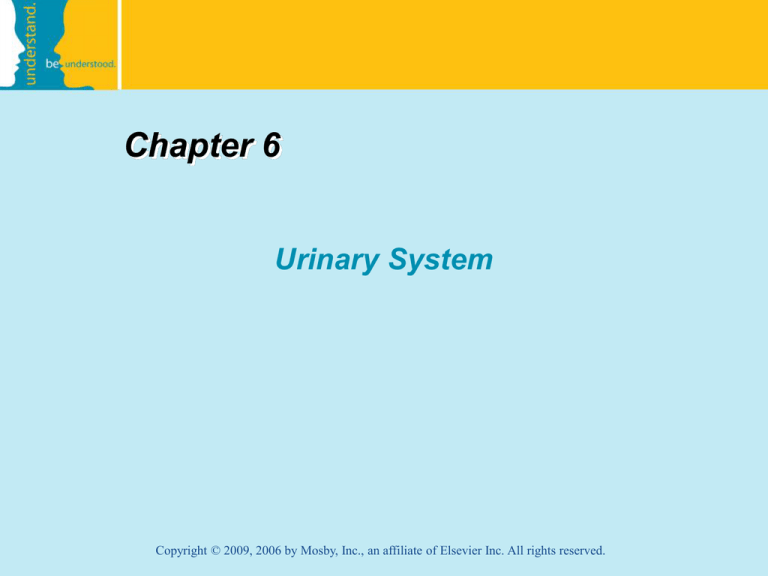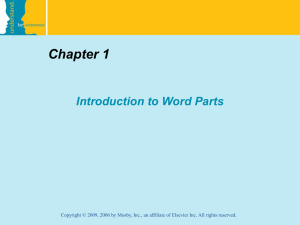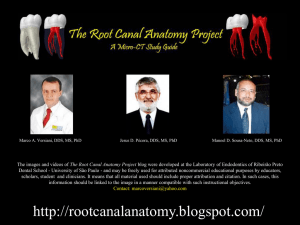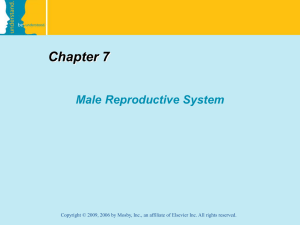
Chapter 6
Urinary System
Copyright © 2009, 2006 by Mosby, Inc., an affiliate of Elsevier Inc. All rights reserved.
Chapter 6
Lesson 6.1
Copyright © 2009, 2006 by Mosby, Inc., an affiliate of Elsevier Inc. All rights reserved.
6-2
Objectives
Identify organs and structures of the urinary
system.
Define and spell the word parts related to the
urinary system.
Define, pronounce and spell disease and
disorder terms related to the urinary system.
Define, pronounce and spell surgical terms
related to the urinary system.
Copyright © 2009, 2006 by Mosby, Inc., an affiliate of Elsevier Inc. All rights reserved.
6-3
Urinary System Function
removes waste material from the body,
regulates fluid volume, and maintains
electrolyte concentration in the body fluid.
Copyright © 2009, 2006 by Mosby, Inc., an affiliate of Elsevier Inc. All rights reserved.
6-4
The Urinary System
Copyright © 2009, 2006 by Mosby, Inc., an affiliate of Elsevier Inc. All rights reserved.
6-5
Male and Female Urinary System
Copyright © 2009, 2006 by Mosby, Inc., an affiliate of Elsevier Inc. All rights reserved.
6-6
Male Urinary Bladder
Copyright © 2009, 2006 by Mosby, Inc., an affiliate of Elsevier Inc. All rights reserved.
6-7
Urinary System
kidneys: 2 bean-shaped organs located on
each side of the vertebral column on the
posterior wall of the abdominal cavity. Their
function is to remove waste products from the
blood and to aid in maintaining water and
electrolyte balances.
nephron: urine-producing microscopic structure.
Approximately 1 million nephrons are located in
each kidney.
renal pelvis: funnel-shaped reservoir that collects
urine and passes it to the ureters
Copyright © 2009, 2006 by Mosby, Inc., an affiliate of Elsevier Inc. All rights reserved.
6-8
Urinary System (cont’d.)
ureters: 2 slender tubes, approximately 10 to
13 inches long, that receive the urine from the
kidneys and carry it to the posterior portion of
the bladder
urinary bladder: muscular, hollow organ that
temporarily holds the urine
Copyright © 2009, 2006 by Mosby, Inc., an affiliate of Elsevier Inc. All rights reserved.
6-9
Urinary System (cont’d.)
urethra: lowest part of the urinary tract
through which urine passes from the urinary
bladder to the outside of the body (female,
approx. 1.5 inches; male, 8 approx inches)
urinary meatus: the opening through which urine
passes to the outside
Copyright © 2009, 2006 by Mosby, Inc., an affiliate of Elsevier Inc. All rights reserved.
6-10
Combining Forms for the
Urinary System
cyst/o, vesic/o
glomerul/o
meat/o
nephr/o, ren/o
pyel/o
ureter/o
urethr/o
Copyright © 2009, 2006 by Mosby, Inc., an affiliate of Elsevier Inc. All rights reserved.
6-11
Combining Forms Commonly
Used with Urinary System Terms
albumin/o
azot/o
blast/o
glycos/o,
glyc/o
hydr/o
lith/o
noct/i
olig/o
son/o
tom/o
urin/o, ur/o
Copyright © 2009, 2006 by Mosby, Inc., an affiliate of Elsevier Inc. All rights reserved.
6-12
Suffixes
-iasis, -esis
-gram
-lysis
-megaly
-ptosis
-rrhaphy
-tripsy
-trophy
-uria
Copyright © 2009, 2006 by Mosby, Inc., an affiliate of Elsevier Inc. All rights reserved.
6-13
Three of Four Suffixes
Beginning with -rrh
Suffix
-rrhea
Meaning
flow, discharge
Chapter
4
-rrhagia
rapid flow of blood
5
-rrhaphy
suturing, repairing
6
Copyright © 2009, 2006 by Mosby, Inc., an affiliate of Elsevier Inc. All rights reserved.
6-14
Three Word Parts that
Incorporate the Root “tom”
Word Part
-tome (S)
-tomy (S)
tom/o (CV)
Meaning
instrument used
to cut
cut into or incision
cut, section
Chapter
4
Copyright © 2009, 2006 by Mosby, Inc., an affiliate of Elsevier Inc. All rights reserved.
5
6
6-15
Clicker Question
Olig/o is a
word root
b) combining vowel
c) combining form
d) suffix
a)
Copyright © 2009, 2006 by Mosby, Inc., an affiliate of Elsevier Inc. All rights reserved.
6-16
Disease and Disorder Terms
Built from Word Parts
cystitis
cystocele
cystolith
glomerulonephritis
hydronephrosis
nephritis
nephroblastoma
nephrohypertrophy
nephrolithiasis
nephroma
nephromegaly
Copyright © 2009, 2006 by Mosby, Inc., an affiliate of Elsevier Inc. All rights reserved.
6-17
Disease and Disorder Terms
Built from Word Parts (cont’d.)
nephroptosis
pyelitis
pyelonephritis
uremia
ureteritis
ureterocele
ureterolithiasis
ureterostenosis
urethrocystitis
Copyright © 2009, 2006 by Mosby, Inc., an affiliate of Elsevier Inc. All rights reserved.
6-18
Helpful Information
To correctly define the terms uremia and
hematuria, start at the beginning of the word.
Uremia is a toxic condition resulting from urea in
the blood. For learning purposes, we have allowed
the definition of uremia to be urine in the blood.
Hematuria means blood in the urine.
Hematuria is a symptom, whereas uremia is a
serious disorder.
Copyright © 2009, 2006 by Mosby, Inc., an affiliate of Elsevier Inc. All rights reserved.
6-19
Disease and Disorder Terms
Not Built from Word Parts
epispadias
hypospadias
polycystic kidney disease
renal calculus (pl. calculi)
renal hypertension
sepsis
urinary retention
urinary suppression
urinary tract infection (UTI)
Copyright © 2009, 2006 by Mosby, Inc., an affiliate of Elsevier Inc. All rights reserved.
6-20
Urinary Tract Infection
Cystitis
Copyright © 2009, 2006 by Mosby, Inc., an affiliate of Elsevier Inc. All rights reserved.
6-21
Clicker Question
Which term means stones in the kidney?
renal hypertension
b) hydronephrosis
c) renal calculi
d) nephromegaly
a)
Copyright © 2009, 2006 by Mosby, Inc., an affiliate of Elsevier Inc. All rights reserved.
6-22
Surgical Terms Built
from Word Parts
cystectomy
cystolithotomy
cystorrhaphy
cystostomy
cystotomy
lithotripsy
meatotomy
nephrectomy
nephrolysis
Copyright © 2009, 2006 by Mosby, Inc., an affiliate of Elsevier Inc. All rights reserved.
6-23
Clicker Question
(renal pelvis) / cv / (stone) / cv / (incision)
The correct term to label the diagram is?
a)pyelolithostomy
b)pyelolithotomy
Copyright © 2009, 2006 by Mosby, Inc., an affiliate of Elsevier Inc. All rights reserved.
6-24
Surgical Terms Built
from Word Parts (cont’d.)
nephropexy
nephropyelolithotomy
nephrostomy
pyelolithotomy
pyeloplasty
ureterectomy
urethroplasty
vesicourethral suspension
vesicotomy
Copyright © 2009, 2006 by Mosby, Inc., an affiliate of Elsevier Inc. All rights reserved.
6-25
Surgical Terms Not Built
from Word Parts
extracorporeal shock wave lithotripsy (ESWL)
fulguration
renal transplant
Copyright © 2009, 2006 by Mosby, Inc., an affiliate of Elsevier Inc. All rights reserved.
6-26
Chapter 6
Lesson 6.2
Copyright © 2009, 2006 by Mosby, Inc., an affiliate of Elsevier Inc. All rights reserved.
Objectives
Define, pronounce and spell diagnostic terms
related to the urinary system
Define, pronounce and spell complementary
terms related to the urinary system.
Interpret the meaning of abbreviations related
to the urinary system.
Interpret, read and comprehend medical
language in simulated medical statements
and documents.
Copyright © 2009, 2006 by Mosby, Inc., an affiliate of Elsevier Inc. All rights reserved.
6-28
Diagnostic Terms Built
from Word Parts
Diagnostic Imaging
cystogram
cystography
intravenous urogram
nephrogram
nephrography
nephrosonography
nephrotomogram
renogram
retrograde urogram
voiding cystourethrography (VCUC)
Copyright © 2009, 2006 by Mosby, Inc., an affiliate of Elsevier Inc. All rights reserved.
6-29
Diagnostic Terms Built
from Word Parts (cont’d.)
Endoscopy
cystoscope
cystoscopy
meatoscope
meatoscopy
nephroscopy
ureteroscopy
urethroscope
Other
urinometer
Copyright © 2009, 2006 by Mosby, Inc., an affiliate of Elsevier Inc. All rights reserved.
6-30
Nephrotomogram
Nephrosonogram
Copyright © 2009, 2006 by Mosby, Inc., an affiliate of Elsevier Inc. All rights reserved.
6-31
Diagnostic Term Not
Built from Word Parts
Diagnostic Imaging
KUB (kidney, ureter, and bladder)
Laboratory
blood urea nitrogen (BUN)
creatinine
specific gravity (SG)
urinalysis (UA)
Copyright © 2009, 2006 by Mosby, Inc., an affiliate of Elsevier Inc. All rights reserved.
6-32
Clicker Question
Which of the following may be used to diagnose
a stone in the tube leading from the kidney to
the bladder?
cystoscopy
b) urethroscope
c) ureteroscopy
d) renogram
a)
Copyright © 2009, 2006 by Mosby, Inc., an affiliate of Elsevier Inc. All rights reserved.
6-33
Complementary Terms
Built from Word Parts
albuminuria
anuria
azoturia
diuresis
dysuria
glycosuria
hematuria
meatal
nephrologist
nephrology
nocturia
oliguria
polyuria
pyuria
urinary
urologist
urology
Copyright © 2009, 2006 by Mosby, Inc., an affiliate of Elsevier Inc. All rights reserved.
6-34
Complementary Terms Not
Built from Word Parts
catheter (cath)
distended
diuretic
enuresis
hemodialysis (HD)
incontinence
micturate
peritoneal dialysis
stricture
urinal
urinary catheterization
urodynamics
void
Copyright © 2009, 2006 by Mosby, Inc., an affiliate of Elsevier Inc. All rights reserved.
6-35
Abbreviations
BUN
cath
ESWL
HD
IVU
SG
UA
UTI
VCUG
Copyright © 2009, 2006 by Mosby, Inc., an affiliate of Elsevier Inc. All rights reserved.
6-36
Clicker Question
Which of the following may be used to
withdraw fluids:
ESWL
b) VCUG
c) cath
d) SC
a)
Copyright © 2009, 2006 by Mosby, Inc., an affiliate of Elsevier Inc. All rights reserved.
6-37
Discharge Summary
Bruno Oliver is a 32-year-old white male, appearing his stated age, who was
admitted to the hospital after presenting himself to the emergency department on
09/20/xx in acute distress. He complained of intermittent pain in the right posterior
lumbar area, radiating to the right flank. He has a family history of nephrolithiasis and
has been treated for this condition two other times in the past ten years.
This patient was admitted to the Urology Unit and was administered intravenous
morphine sulfate for pain control. VITAL SIGNS: Low-grade temperature of 99.4.
Initial blood pressure was 146/92.
The white blood count, hemoglobin, and hematocrit normal. The urinalysis showed
microscopic hematuria.
A KUB revealed calculi in the region of the right renal pelvis. A cystoscopy with a
right retrograde urogram confirmed the presence of the three stones in the right
kidney. Minimal ureteral obstruction was present.
A percutaneous nephropyelolithotomy was completed with no complications. A
ureteral stent was inserted as was an indwelling Foley catheter. Drainage from the
right kidney was pale yellow in 48 hours. The Foley catheter was removed three
days postoperatively.
At discharge, the patient is voiding without difficulty. The stones were sent to the
laboratory for analysis. The report indicated that they were calcium oxalate.
The patient is to follow up with his urologist in a week to have his ureteral stent
removed.
Copyright © 2009, 2006 by Mosby, Inc., an affiliate of Elsevier Inc. All rights reserved.
6-38







